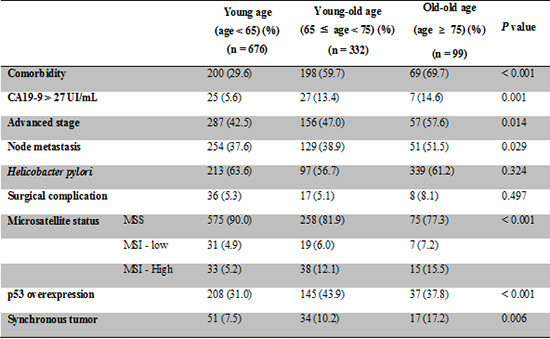1. Stewart BW, Kleihues P. Prevention and screening. In : Stewart BW, Kleihues P, editors. World cancer report. Lyon: IARC Press;2003. p. 194.
2. Wang Y, Huang X, Xing B. Gastric carcinoma in the young people. Zhonghua Wai Ke Za Zhi. 1997; 35:271–273.
3. Lo SS, Kuo HS, Wu CW, Hsieh MC, Shyr YM, Wang HC, Lui WY. Poorer prognosis in young patients with gastric cancer? Hepatogastroenterology. 1999; 46:2690–2693.
4. Moghimi-Dehkordi B, Safaee A, Fatemi R, Ghiasi S, Zali MR. Impact of age on prognosis in Iranian patients with gastric carcinoma: review of 742 cases. Asian Pac J Cancer Prev. 2010; 11:335–338.
5. Kim DY, Joo JK, Ryu SY, Park YK, Kim YJ, Kim SK. Clinicopathologic characteristics of gastric carcinoma in elderly patients: a comparison with young patients. World J Gastroenterol. 2005; 11:22–26.
6. Wang JY, Hsieh JS, Huang CJ, Huang YS, Huang TJ. Clinicopathologic study of advanced gastric cancer without serosal invasion in young and old patients. J Surg Oncol. 1996; 63:36–40.
7. Saif MW, Makrilia N, Zalonis A, Merikas M, Syrigos K. Gastric cancer in the elderly: an overview. Eur J Surg Oncol. 2010; 36:709–717.
8. Ershler WB, Longo DL. The biology of aging: the current research agenda. Cancer. 1997; 80:1284–1293.
9. Lim MC, Kang S, Song YJ, Park SH, Park SY. Feasibility and safety of extensive upper abdominal surgery in elderly patients with advanced epithelial ovarian cancer. J Korean Med Sci. 2010; 25:1034–1040.
10. Shin DW, Cho B, Kim SY, Jung JH, Park JH. Management of cancer survivors in clinical and public health perspectives: current status and future challenges in Korea. J Korean Med Sci. 2013; 28:651–657.
11. Bani-Hani KE. Clinicopathological comparison between young and old age patients with gastric adenocarcinoma. Int J Gastrointest Cancer. 2005; 35:43–52.
12. Kubota H, Kotoh T, Dhar DK, Masunaga R, Tachibana M, Tabara H, Kohno H, Nagasue N. Gastric resection in the aged (> or = 80 years) with gastric carcinoma: a multivariate analysis of prognostic factors. Aust N Z J Surg. 2000; 70:254–257.
13. Choi JY, Shim KN, Roh SH, Tae CH, Kim SE, Jung HK, Kim TH, Jung SA, Yoo K, Moon IW. Clinicopathological characteristics of gastric cancer and survival improvement by surgical treatment in the elderly. Korean J Gastroenterol. 2011; 58:9–19.
14. Arai T, Esaki Y, Inoshita N, Sawabe M, Kasahara I, Kuroiwa K, Honma N, Takubo K. Pathologic characteristics of gastric cancer in the elderly: a retrospective study of 994 surgical patients. Gastric Cancer. 2004; 7:154–159.
15. Yamashita K, Sakuramoto S, Katada N, Futawatari N, Moriya H, Hirai K, Kikuchi S, Watanabe M. Diffuse type advanced gastric cancer showing dismal prognosis is characterized by deeper invasion and emerging peritoneal cancer cell: the latest comparative study to intestinal advanced gastric cancer. Hepatogastroenterology. 2009; 56:276–281.
16. Byun C, Han SU. Surgical management of advanced gastric cancer. Korean J Helicobacter Up Gastrointest Res. 2013; 13:138–141.
17. Marrelli D, Morgagni P, de Manzoni G, Coniglio A, Marchet A, Saragoni L, Tiberio G, Roviello F. Prognostic value of the 7th AJCC/UICC TNM classification of noncardia gastric cancer: analysis of a large series from specialized Western centers. Ann Surg. 2012; 255:486–491.
18. Kang HY, Kim SG, Lee MK, Kim JS, Jung HC, Song IS. Italian Research Group for Gastric Cancer (IRGGC). Effect of Helicobacter pylori eradication according to the IL-8-251 polymorphism in Koreans. J Korean Med Sci. 2012; 27:1202–1207.
19. Radovanović D, Knezević M, Canović D, Aćović L. Correlation between p53 expression and clinical-pathological characteristics of gastric cancer. Vojnosanit Pregl. 2011; 68:832–836.
20. Esaki Y, Hirokawa K, Yamashiro M. Multiple gastric cancers in the aged with special reference to intramucosal cancers. Cancer. 1987; 59:560–565.
21. Mitsudomi T, Watanabe A, Matsusaka T, Fujinaga Y, Fuchigami T, Iwashita A. A clinicopathological study of synchronous multiple gastric cancer. Br J Surg. 1989; 76:237–240.
22. Kitamura K, Yamaguchi T, Okamoto K, Otsuji E, Taniguchi H, Hagiwara A, Sawai K, Takahashi T. Clinicopathologic features of synchronous multifocal early gastric cancers. Anticancer Res. 1997; 17:643–646.











 PDF
PDF ePub
ePub Citation
Citation Print
Print








 XML Download
XML Download